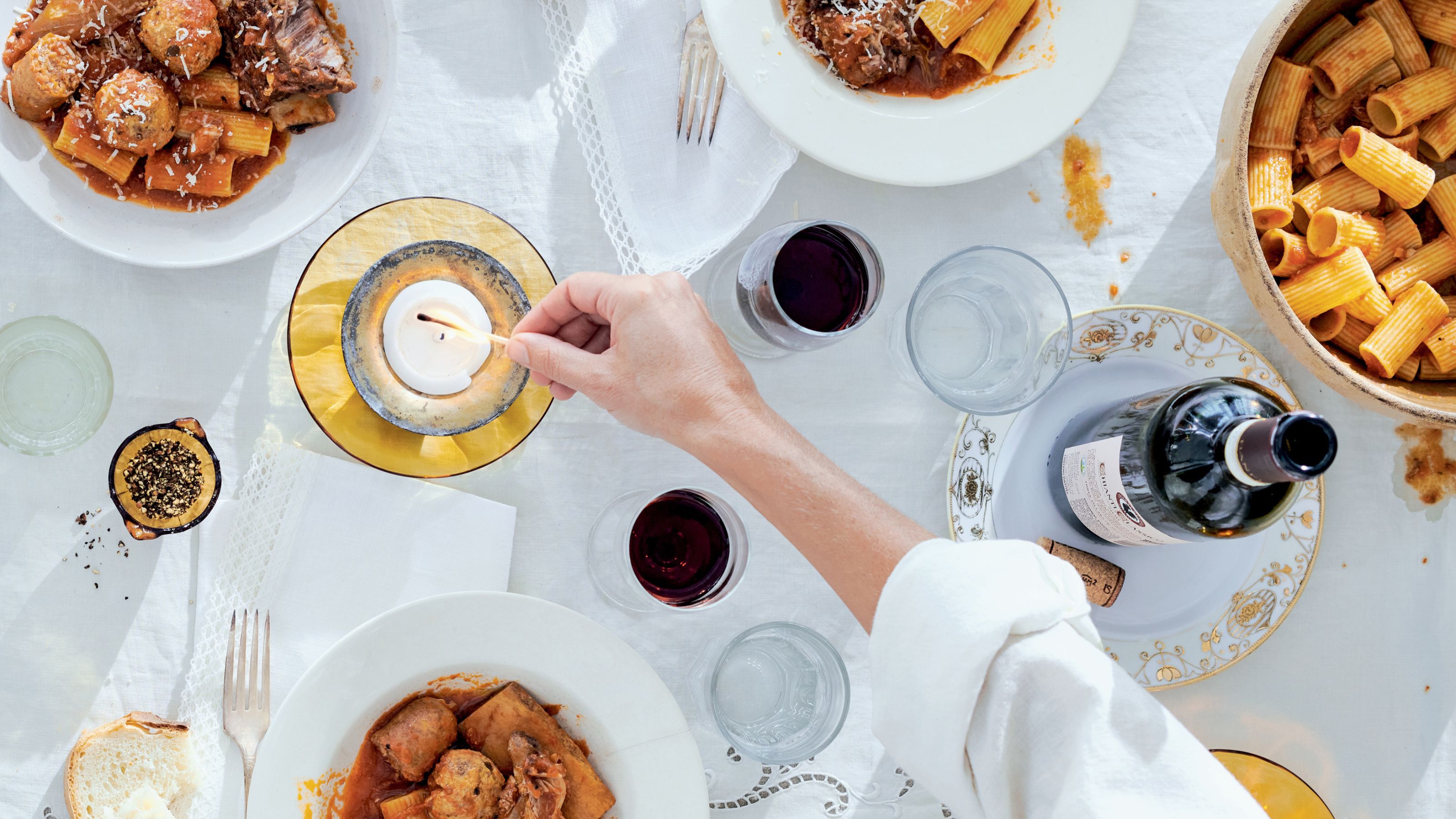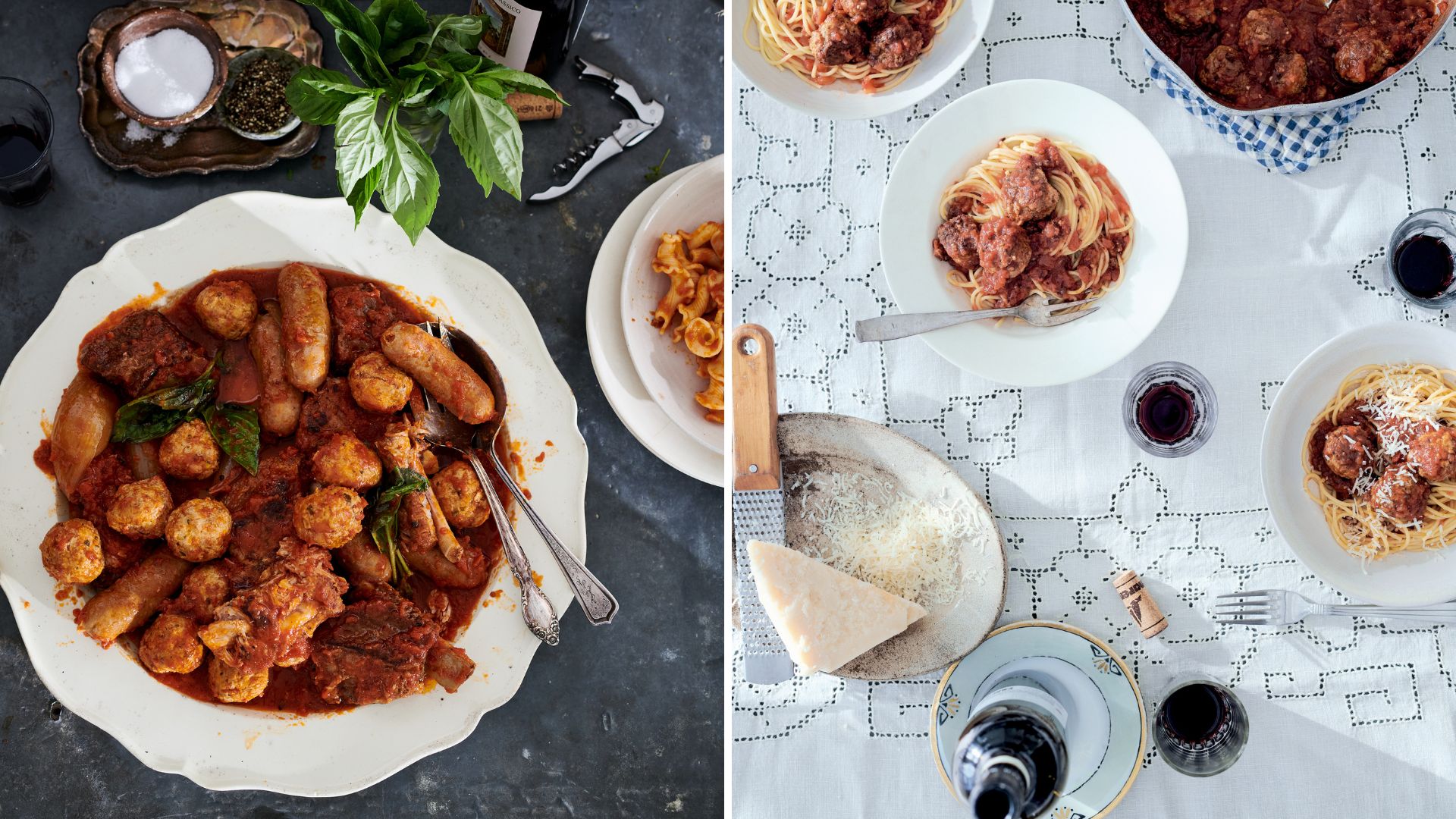A Cook's Legacy: Sunday Dinner Can Be As Simple as You Want – the Point Isn't the Menu it's the Moment
A simmering pot of comfortingly simple ingredients, tossed together with steaming strands of pasta – my Sunday Sauce recipe is the foundation of meaningful gatherings


Just last week, some friends visiting from abroad texted me on a Sunday to say they’d love to get together while they were in town. 'But don’t go to any trouble – we’ll just order a pizza, they said. I laughed. 'Too late,' I told them. 'I’ve already been cooking all morning.' That’s what happens on Sundays in my house. Even if I don’t know who’s coming by, there’s always something simmering on Sundays: A pot of beans; a red sauce; a pan of green beans braised with garlic and vinegar. This is the ritual of Sunday Sauce. Cooking slows me down – it’s the one thing that grounds me at the end of a week, stretches the weekend, connects past and present, and feeds everyone you love. It's the foundation of my cookbook, Mother Sauce.
The Sauce That Built a Sunday
I grew up with the tradition of Sunday Sauce, or what some call 'Sunday Gravy.' In New Jersey and South Philadelphia, they’ll tell you gravy is a tomato sauce enriched with meat drippings. In Boston, Chicago, Rhode Island, and San Francisco, it’s just 'sauce.' Whatever you call it, it’s meant to feed everyone after a Catholic Mass, on a family Sunday around the table – the so-called day of rest, which was never restful for the women stirring the pots.
The ritual came out of cucina povera – the make-do cooking of Italian immigrants who arrived in America with cooking and foraging skills, but little money. They knew how to stretch food: simmering the tough end cuts of beef and pork into tenderness, coaxing flavor from bones and scraps, and turning a humble can of tomatoes into a meal. When those families came to America, they found bounty in the seas and forests and markets, and butchery that was available to all. Sunday became the day to put it all together: a sauce that could handle the cuts of meat the more monied customers left behind, and a way to serve every cousin who happened to drop in.
The Women Who Made It Happen
When I was little I remember my grandmother’s small yellow kitchen, where the light would filter through the colored glass panes in the window. Women in floral house dresses moved in and out of the garden, chatting in half English, half Italian, frying pizza fritta for the kids, arguing about meatballs. (One side of the family swore you had to brown them first; the other side insisted you dropped them directly into the simmering sauce.) There were no recipes – just instinct, and whatever the butcher had left at the end of the week.
By the time everyone came home from church, the table was set with roasted peppers, fennel, cheese, bread, and platters of pasta in that deep, rich red sauce. There was always enough. If someone brought a friend, a boyfriend, or a stray neighbor, the answer was never no. You just squeezed in another chair.

My Own Way with Sunday Sauce
A century later, my Sunday Sauce still follows those roots – but with a few modern tweaks. I don’t make my own sausage, but I’m particular about how I cook it. Sausages vary wildly – too much fennel here, too garlicky there – so I brown them separately and add them back at the very end. It keeps the flavor clean and the sauce balanced.
I also follow Marcella Hazan’s trick of adding a whole onion to the simmering sauce, then pulling it out before serving. It perfumes the pot without leaving bits of onion behind. As for meatballs, I’m flexible. If my son is coming, they’re non-negotiable – he’d never forgive me if they weren’t in the pot. When I’m feeding a crowd, I drop them directly into the sauce for the last half hour so they absorb its flavor without drying out.
And, because I never know whether four or twenty people will show up, I make more than I need. The extra goes into quart containers to freeze or send home with guests. A good sauce reheats in the time it takes to boil pasta – my idea of the perfect weeknight gift.
A Modern Sunday Mindset
People tell me all the time, 'I’d love to do a Sunday dinner, but it’s too much work.' I tell them it can be as simple as you want: canned tomatoes, a splash of wine, a plate of pasta, maybe a salad. The point isn’t the menu – it’s the moment. I’ve worked demanding jobs or booked TV appearances on a Sunday so I always believed in sharing the work. When I leave I’ll tape a note to the fridge that says, Turn off the sauce at 11, trim the beans, set the table. Everyone contributes. And, unlike when I was growing up, it’s not only the women doing the dishes at the end of the meal either!
I’m not a baker, so I make it easy on myself for dessert too: When the meal’s over, I make a little platter of roasted nuts, dried fruit, and chocolate with a bottle of Marsala or port. It’s a gentle landing, a way to linger.
Saving Your Sundays
For me, Sunday Sauce is less about religion now and more about reverence – for the day, for the people, for the pause before the week begins again. I even play a mental trick to ensure that my Monday – whatever it holds – doesn’t ruin my Sunday: I just pretend Sunday is Saturday until midnight. It keeps the anxiety of the week at bay and stretches the feeling of the weekend a little longer.
So whether it’s four people or twenty, whether you simmer all day or throw together pasta in thirty minutes, don’t let Sunday escape without a meal to mark it. Make a pot of sauce, open your door, and let Sunday linger.
Lucinda's Sunday Sauce Recipe
Sunday Sauce is chock-full of meats and a couple dozen simmering meatballs, and, on special occasions, Beef Braciola. Sometimes a simple dish of spaghetti twirled in a buttery smooth Tomato Sauce is all you want!

Ingredients (serves 8-10)
- 1 pound (455 g) pork ribs – country-style, back ribs, or spareribs 1 pound (455 g) bone-in beef shank, chuck, or short ribs
- Coarse salt and freshly ground black pepper
- ⅓ cup (80 ml) extra virgin olive oil
- 9 garlic cloves, thinly sliced
- 1 onion, halved lengthwise, root end left intact to hold the layers together
- Three 28-ounce (800 g) cans whole tomatoes, coarsely blended or chopped
- 2 large sprigs fresh basil
- 12 meatballs – see below
- 1 pound (455 g) sweet or hot Italian sausages (optional), each poked in several spots
- 3 pounds (1.4 kg) macaroni, such as rigatoni, penne, fusilli, or campanelle
- Grated Parmesan or Romano cheese for serving
- For the meatballs
- 1 pound ground meat (pork, beef, veal, turkey, or chicken, or a combination)
- 1 cup breadcrumbs soaked in ¼ cup warm milk
- 1 large egg
- ⅓ cup Romano or Parmesan grated cheese
- 1 large garlic clove, minced
- Leaves from 3 sprigs fresh flat-leaf parsley, finely chopped
- ¾ teaspoon dried herbs, such as oregano, thyme, or basil, or a combination (optional)
- ½ - 1 teaspoon kosher salt, to taste
- ½ teaspoon freshly ground black pepper
- 2 tablespoons extra virgin olive oil
Method
- Generously season the pork and beef with salt and pepper. Heat a large heavy pot over medium-high heat and swirl in the olive oil. When it glistens, and working in batches, add the meat to the pot and sear on all sides until golden brown, 8 to 10 minutes. Transfer to a plate.
- Pour off most of the excess fat, leaving about ¼ cup (60 ml) in the pot. Reduce the heat to medium, add the garlic and onion, and cook, stirring constantly, for a minute, being careful not to burn them. Pour in the tomatoes, then half-fill one can with water and add to the pot, scraping the brown bits off the bottom. Return the meat and any accumulated juices to the pot and simmer, partially covered, for 1½ hours.
- For the meatballs: Transfer the soaked breadcrumbs to a large bowl. Add the meat, cheese, egg, garlic, parsley, dried herbs, salt, and pepper and combine the mixture with your hands. Moisten your hands to make it easier to shape the meat mixture and roll it into 1½-inch (4 cm) balls; transfer them to a baking sheet as you form them. Heat a large skillet over medium-high heat and swirl in the olive oil. When it glistens, add the meatballs in a single layer, leaving some room around them (cook in batches if necessary). Reduce the heat to medium and brown the meatballs on all sides, 5 to 6 minutes.
- Remove the onion halves from the pot and discard. Increase the heat to high and carefully drop in the meatballs one by one, gently stirring (so they don’t break apart before they are firmly set) as you go to coat them in the sauce. Add the basil sprigs, reduce the heat to low, and simmer, partially covered, until the meatballs are cooked through, about 30 minutes.
- Meanwhile, poke each sausage a couple of times with a fork or sharp knife. Place the sausages and 1 cup (240 ml) water in a large skillet and bring to a simmer over high heat. Simmer, turning to brown the sausages on all sides, until most of the water has evaporated, about 8 minutes. Pour off any excess fat and add 1 cup (240 ml) of the simmering tomato sauce to the pan; remove from the heat and cover to keep warm. (When ready to serve, add the sausages to the bowl with the rest of the meat.)
- While the sausages are cooking, bring a large pot of salted water to a rolling boil and warm a large serving bowl. Add the macaroni (1 pound at a time unless the pot is very big) to the pot and cook for 2 minutes shy of the package instructions (the pasta should be slightly soft but with a firm chew to it). Drain the noodles, transfer them to the warm bowl, and stir in some sauce to coat. Repeat with the remaining macaroni. (If cooking all 3 pounds/1.4 kg of pasta at once, drain the noodles, return them to the pot, and stir in some sauce to coat. When ready to serve, fill the warm bowl with the sauced pasta and refill as necessary.)
- If serving family-style, warm another large serving bowl and fill it with the meat and sauce. If serving individually, heat the pasta bowls or plates before serving by setting them on or next to the oven, on a warm stovetop, or in a low oven. Place extra sauce and meat in a small warm bowl on a plate, with a large spoon or small ladle. Either way, place a small dish (or two) of grated cheese on the table.
- Keep a stash of reusable storage containers on hand to fill with any leftovers (pasta, sauce, and meat) and send home with your guests. Or store the leftovers in the refrigerator for 3 to 4 days or in the freezer for up to 6 months.
A Cook's Legacy is our six-part series with award-winning cookbook author, Lucinda Scala Quinn, exploring the family, food, and cultural memory that inspired her latest cookbook, Mother Sauce, through her beloved culinary voice.

The author of eight cookbooks and long-time food director at Martha Stewart Living, Scala Quinn has spent decades showing home cooks how to bring restaurant-worthy meals to the family table.